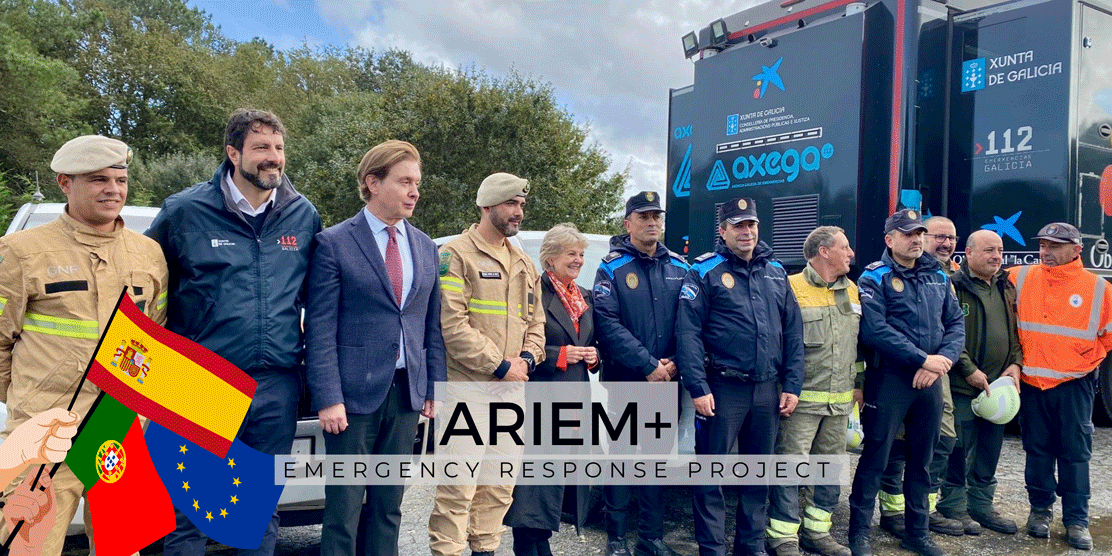ARIEM+ emergency response project brings Spain and Portugal closer
- 24 Jan 2024

Acting together in a coordinated way across borders to help each other during emergencies not only boosts morale but creates a sense of togetherness and belonging. With climate change, natural risks in Europe are becoming more frequent and require coordinated responses across the European Union.
Natural risks and emergencies know no borders. Thankfully, neither do the Spain-Portugal emergency teams working on the ARIEM+ Interreg cooperation project. ARIEM+ has defined a Cross-Border territorial Emergencies plan and created a Single Operational Command Network for the joint management of human and material resources in risk situations, especially those derived from climate change (forest fires, floods). The project also includes aspects such as the training of personnel and awareness raising among the general population on both sides of the Spain-Portugal border.
The project under its full title “Interregional Mutual Assistance in Emergencies and Cross-border Risks (ARIEM+)” is funded in the framework of the Interreg V-A Spain Portugal 2014-2020 programme, in which the Galician authorities act as the main beneficiary. It is a mechanism for collaboration between those responsible for the management and mobilisation of resources in the event of major emergencies in southern Galicia, Castile and Leon in Spain and northern Portugal.
The main objectives of the project are to: -
- Increase territorial resilience against cross-border natural risks;
- Promote investment to address specific risks, ensuring resilience to disasters and developing systems for disaster management;.
- Define a territorial plan for Cross-border emergencies and prepare a risk map;
- Create a single operational command network for coordinating emergency assistance.
When the cross-border region of Spain and Portugal faces a flood, forest fire, missing person or other emergency situation, emergency services from the Galicia, Castilla y León and Norte regions can now respond in a coordinated and efficient manner.
Although emergencies know no borders, emergency management services (EMS) do. When an emergency strikes a cross-border region, a coordinated response from all sides can be easily impeded by different administrative procedures, national regulations and language barriers — and EU citizens suffer as a result.
To ensure that the citizens of Spain’s Galicia and Castilla y León regions and Portugal’s Norte region benefit from an optimal level of emergency services, the ARIEM+ project introduced a centralised framework to facilitate collaboration between each region’s emergency response teams.
Overcoming barriers
Before ARIEM+, when a forest fire or flood hit a cross-border area, an Emergency Medical Services (EMS) team from Galicia could only provide emergency services up to its border, where on the other side Portuguese first responders would be working in accordance with their own protocol. Although the wildfire was clearly indifferent to national borders, the people on the ground were very much restricted by them. Now, with ARIEM+, there is an established framework for coordinating cooperation between the three regional EMS programmes. The result is a more efficient use of existing resources, quicker response times and more lives saved.
The cross-border emergency framework is comprised of several components, including joint action protocols, new technologies, coordinated training and drills and shared resources. For example, the project’s Remote Manager computer application provides all participating emergency responders with coordinated information, including GIS-based mapping, in real-time. To prepare the teams for a joint emergency response, the project brought personnel from all three regions together for several training sessions and drills.
Shared resources for a more effective service
The project has also taken great strides in helping the three regions pool their resources in order to avoid duplication or redundancies. For example, the three EMS teams purchased two shared drone units that have proved instrumental in controlling natural disasters, preventing fires and finding missing persons.
Cooperation between Spanish and Portuguese EMS teams has become so close that there are examples of an EMS team from a ‘home’ country discovering an emergency on the other side of the border. Under such circumstances, both teams work together to deal with the emergency.
In addition to the drones, an array of other emergency tools and equipment have been jointly purchased, including: a video conferencing system, 380 Tetra terminals, mass faxing broadcast alert system, geolocation application, a semi-trailer tractor, three tankers, 1 465 clamp fire hoses, 13 300 smoke detectors, five emergency release fire systems, four thermal cameras, two boats, two pick-ups and trailers and 110 autonomous breathing systems.
But the project is about much more than simply purchasing equipment – it’s also putting it to use. Since its launch, the project has successfully coordinated a joint response to several cross-border emergencies, including to an industrial fire, a fisherman lost at sea and a forest fire – to name only a few. As these situations clearly confirm, the ARIEM+ project has achieved its objective of responding to cross-border emergencies with a quick, effective and coordinated effort.


